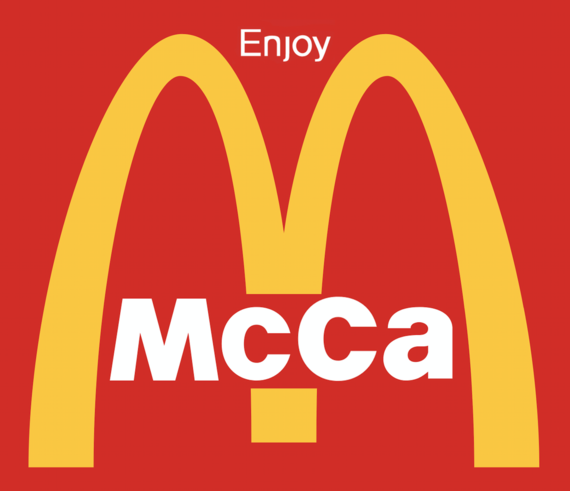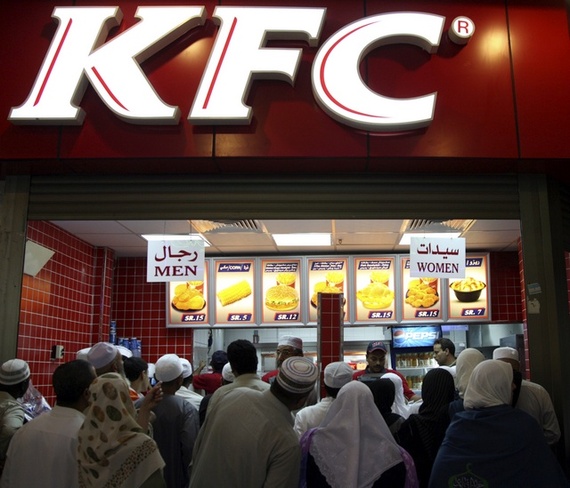The holy land of Hejaz, home to the two holy cities of Mecca and Medina, is a strictly Muslims-only area as non-Muslims are not issued visas to that region. One would assume that Mecca is a city of religious purity and traditionalism. However, a visit to the holy city a couple of years ago led me to the astonishing realization that the troops of globalization have reached not only the Saudi Kingdom, but the cradle of Islam as well.
Being a good "Custodian of the Two Holy Mosques" has been and remains a source of pride and legitimacy for the Saudi rulers. Starting from the 1970s, booming oil prices unleashed a wave of infrastructural modernization programs and enabled generous efforts to accommodate those making the great pilgrimage (Hajj) or small pilgrimage (Umra). Today, Mecca has the necessary infrastructure to welcome more than twelve million pilgrims a year, a number expected to rise to 17 million by 2025. Rapid modernization resulted in the drastic revamping of the image of the holy city. However, pilgrims (Hajjis) who wish to walk the path of the Prophet Muhammad, or to visit sites where famous events of early Islam took place, will be definitely disappointed. Today's Mecca has more in common with the flamboyance of Dubai than with a romantic place of pilgrimage.
According to the rules of the Meccan real estate market, the closer a property to the Grand Mosque (al-Haram), the more expensive it is. Therefore, old buildings are wiped out from the area of Mecca's old town. The sites of historical events can only be located approximately. The house where the Prophet Muhammad was born is now a library, while other important sites are lost in the shade of skyscrapers. The Western-style towers obscuring the sky around the Haram have little to do either with Arabic, or with Islamic architecture. Some Muslim scholars see them as a sign of the Day of Judgement and quote a hadith of the Prophet Muhammed that predicts that the last day will come when the guardians of Mecca compete in building tall structures around al-Haram. Judging from the 600 meter tall high Royal Mecca Clock Tower - the world's largest clock face and second tallest skyscraper - that looms over the Grand Mosque from the south, the Day of Judgement is frightfully close.
Walking on the streets of Mecca, Hajjis experience a hybrid mix of Wahhabi puritanism and Western consumer culture. Even though the advertisements do not feature human figures, the sheer number of sellout signs evokes Paris in the days before Christmas. Of course, prices are usually up during the days of Hajj. Pilgrims spend more than 5 billion riyals (1.33 billion USD) each year to buy souvenirs for friends and relatives back home. Even before the appearance of the Prophet Muhammad, Mecca had been a commercial hub where caravans from Syria met their peers from Yemen. The members of the Quraysh tribe ruling the city in the early 7th century were powerful merchants who gained profit from trading. Muhammad also recognized the importance of trade and Mecca thus remained a call of port for goods even after the capital of the Islamic empire moved from Hejaz to Syria and, later, to Iraq. However, the Wall Street style boutiques surrounding the Mecca Clock Tower are more like Western luxury malls than traditional souks. Wealthy pilgrims can do their shopping at Mango, Ralph Lauren and a spate of other Western luxury boutiques in extravagant plazas, while poorer Hajjis can purchase cheaper clothing and Made in China miniature models of the Kaaba from street vendors.
When it comes to eating in Mecca, forget traditional Saudi dates and lamb. The main fare and the most readily available dish is American junk food. Leaving the Haram Mosque through the King Fahd Gate, the first sign a pilgrim sees is a KFC advertisement offering "Hajj ad Umra Meals" containing rolls, fries and halal drumsticks for 15 riyals (4 USD). As the box does not include drinks, thirsty pilgrims have to buy their own. Unfortunately, there are few alternatives to Pepsi products, bottled in the western region of Saudi Arabia. Coca Cola, boycotted by some Muslims for the company's alleged support of Israel, is still available in McDonald's restaurants on al-Houjoon Street, less than two miles away from the Haram.
There are many places where one can eat and drink around the Grand Mosque. On the first floor of the neighboring plaza, a Starbucks Coffee offers real Americanos, and Pizza Hut and Burger King too offer their fare. The most tragicomic sight I personally experienced was a Nigerian Hajj praying outside the Haram who used a torn Pizza Hut box for a carpet, placing his forehead right on the logo while bowing.
Mecca can accommodate up to three million people during Hajj season. Of course, the price of hotel rooms often goes up tenfold during those days. The wealthiest pilgrims can stay in the Mecca Hilton, part of the Hilton chain, which will soon be inherited by scandal-star Paris Hilton. The 30-storey luxury hotel offers rooms with view of the Kaaba for a price starting from around 200 USD per person per night.
While the globalization of Mecca might disturb Muslims, it does not legally conflict with Islamic law. At the same time, several other phenomena are hardly compatible with Sharia law. For example, taking photos inside the Haram is strictly forbidden as Salafis hold that taking pictures of live creatures is an act forbidden by God. This regulation, easily imposed in the age of normal cameras, is now unenforceable. I saw iPhones, BlackBerrys, and Samsung Galaxys and other smartphones merrily clicking away around the Kaaba and the powerless security guards watching it. The list of controversies does not end here. Just a stone's throw away from al-Haram, there are branches of the Riyad Bank and other financial institutions that owe a fair share of their profit to applying interest (known as Riba in Arabic), a practice strictly forbidden by Islamic law. The Saudi British Bank, the Saudi Hollandi Bank and the Banque Saudi Fransi are also proud to have branches in the Holy City.
"Why can a mosque can be built in Europe and America, and why can't a church be erected in Saudi Arabia?" is one of the questions asked by opponents of Islamic expansion. The heart of the Muslim world is not as closed to foreign impacts as one might assume.
Globalized Western values are spread not only by missionaries, but also through the promotion of a lifestyle and a society based on the consumption of goods, which is at least as incompatible with puritan Islamic values as is Sharia law with liberal Western ideas. Having a McDonald's, a Hilton and Western-style banks in Mecca is no less controversial than having a grand mosque in the centre of Rome, hearing the call of the muezzin echoing through the Swiss Alps, or, let's say, having a mosque a block away from Ground Zero.

